Travelling with Tribal Tracks is a wonderful experience. They take care of everything and you don't have to worry about anything!
Gordon G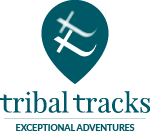
Location
Terrain
Difficulty
Accommodation and Meals
Hotel
Duration
6 days
Meeting Point
Naples
Annual Leave
4 days
Group Size
Up to 20
Seasons
Walking Distance
50km approx
A journey steeped in military history
A challenging trek on the Million Dollar Mountain
A moderate trek on the so-called 'German Eye'
Hike the Cavendish Road
Trek alongside local guides and historians to share wartime facts and stories
Visit several war memorials and cemeteries
All the info you need
Trip Details
Experience the breathtaking landscapes of the Italian countryside. From rolling hills to panoramic vistas, each step offers a new perspective and a deeper connection to the land’s storied past.
Embark on a journey that transcends mere travel—a powerful blend of history, reflection, and adventure awaits you on the Monte Cassino Trek with Tribal Tracks. This unique expedition invites you to walk in the footsteps of heroes, exploring the rugged terrain of southern Italy while honoring the legacy of those who fought in one of World War II’s most pivotal battles.
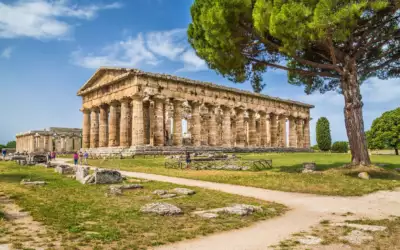
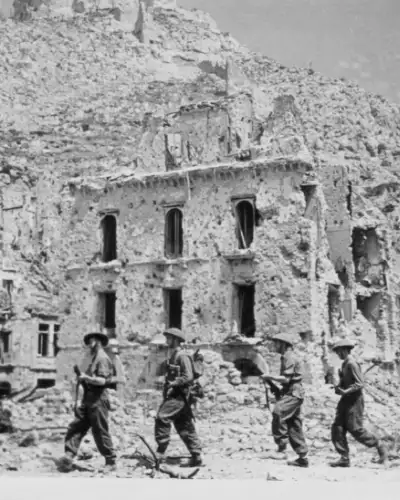
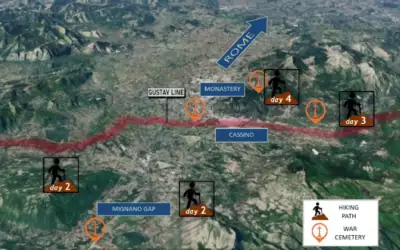
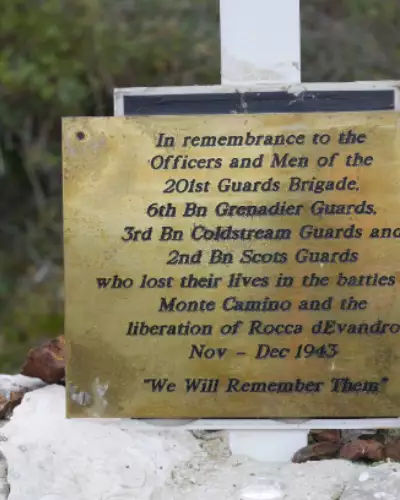
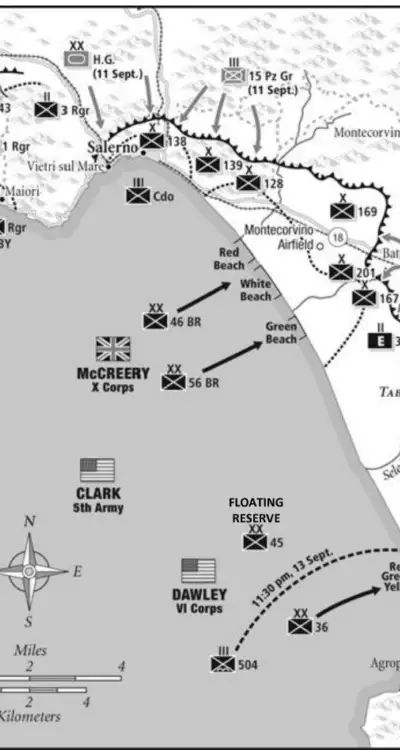
Trip Details
To Naples
Arrive Naples airport. Transfer to Salerno.
Your Tribal Tracks adventure begins the moment you touch down in Naples! As you step off the plane, soak up that warm Italian sunshine and keep your eyes peeled for your friendly driver and guide for the week.
Your private transfer will head south east with the imposing active stratovolcano Vesuvius on your left, and the Tyrrhenian Sea to your right. Use this hour to begin to get to know your fellow adventurers before arriving in the charming town of Salerno.
Accommodation and Meals
Hotel, LD
The Million Dollar Mountain - Operation Raincoat
Today, we journey back to November 1943, when a British military operation faced one of the grueling battles on Monte Camino (960 m), a key stronghold of the Winter Line (aka the Gustav Line). This wasn't just any battle—this was a clash where bravery met brutal reality.
Underestimations and overlooked challenges led the troops into unexpectedly fierce resistance where every soldier faced danger head-on, whether face-to-face combat to overwhelming artillery fire. Not only this, but the steep mountainous terrain and harsh winter conditions turned an already daunting mission into a relentless fight against nature, too!
The battle endured staggering losses and although the initial Operation Raincoat assault failed to secure Monte Camino, it paved the way for a larger and more successful assault in December 1943, eventually leading to the Allied capture of the mountain and the collapse of the Bernhardt Line in that sector.
9km, elevation gain 650 m (challenging hike)
Accommodation and Meals
Hotel, BLD
Mount Cifalco - “The German Eye”.
Monte Cifalco is a high mountain with steep slopes that dominates nearly the whole of the Belvedere massif. The German Observation Posts kept the French Canadian (the CEF) busy in the attempt to conquer Colle Belvedere and Colle Abate in a week-long battle from 25 January to 3 February 1944.
To warn the French of the danger from the German artillery at Cifalco, the service units installed signs with the words “you can be seen at Cifalco“. The Germans not only had the ideal position from which to fire their shells, but they also had a natural shelter that protected them from aerial bombardment and artillery.
From the top of the Cifalco, and from the defensive bunkers built into the mountain, the Germans could see every Allied position - the entire Rapido Valley, Cassino town and Abbey and the Liri plain below it in observation. The Germans could order accurate artillery fire on anything that moved below, thus earning the mountain the nickname of 'German Eye'.
Trek 6.5km, 400m elevation gain (moderate hike)
After our trek and lunch, we will visit the meticulously maintained grounds of the German Cemetery at Caira, the final resting place for around 20,000 soldiers. We honor the memory of all those who lost their lives and remember war's devastating cost.
We end our day of exploration with a stroll around the Commonwealth War Cemetery and War Memorial. We will walk among the graves, discovering names, dates, unit insignia, and religious emblems; the sheer number and variety of these emblems offer a powerful visual representation of the multinational forces involved in the Battle of Cassino. The abundant and carefully cultivated flowers enhance the atmosphere of respectful remembrance. We will learn about often-overlooked aspects of the war and honor the heroes who fell, including those whose bodies were never recovered.
Accommodation and Meals
Hotel, BLD
Trek the Inferno Track - Acquafondata to the Valle del Rapido
The Inferno Track is a downhill path (a dried-up riverbed) starting from the hills and descending to the plain, making it a practical and enjoyable adventure, surrounded by mountain scenery and steeped in military history.
This trail was the first supply path used by the French forces in January 1944 to aid the American troops at Monte Cassino. It was out of enemy sight. Later, it was also utilized by New Zealand and Polish contingents, playing a crucial role in logistical support through supply and provisioning for the Allied forces during World War II. An extract from a War Diary in 1944 predicted that once the war concluded, the track would become an Italian scenic wonder.
Trek distance: 12 to 15 km
Accommodation and Meals
Hotel, BLD
Monte Cassino- Trek, cemetery and Abbey.
This morning, we will conquer Monte Cassino. We will have an unforgettable hike on the iconic battlefield trails of Monte Cassino, climbing the ancient mule track known as 'Cavendish Road,' which became famous for the lost attempt at a surprise and daring assault of the American tanks on the German defences. The German 4th Parachute Regiment, which was positioned behind the monastery, was able to stem the attack by disabling the first dozen tanks near to the medieval Albaneta Farm, and the remaining ones were forced to retreat. To read more about this attack before your visit, we recommend reading Jeffery Plowman's 'Tank Attack at Monte Cassino: The Cavenish Road Operation 1944'.
19km/6 hr trek. Elevation gain 550 m (moderate hike)
In the afternoon, we will visit the Polish Cemetery & Memorial Museum. This serves as a poignant and moving tribute to over a thousand Polish soldiers who lost their lives during World War II, particularly at Monte Cassino. The rows of white headstones stand in solemn formation. The cemetery provides a peaceful and reflective atmosphere, boasting stunning views of the Abbey and the surrounding area. The visitor center will offer us context about the battles through maps, letters and photographs. Overall, the cemetery stands as a significant memorial, inviting visitors to pay tribute, reflect, and remember the sacrifices of those who served with honor during such a tumultuous time in history.
The last outing in Cassino will be to finally visit the Abbey of Montecassino. This magnificent building has been at the center of discussion for over 80 years, having played a significant role in the tumult of war. We'll uncover stories of resilience and renewal that make this place so extraordinary. This last inspiring visit is not just about history but also about reflecting on our journey and celebrating the peace we cherish today.
Accommodation and Meals
Hotel, BLD
The end of our adventure
After this educational and emotional journey, we'll transfer by minibus back to Naples in time for our flight.
Accommodation and Meals
NA, B
Trip Details
Trip Details
In a nutshell, almost everything!
This is what you will need to buy/source yourself.
It is important that you read the itinerary carefully, and take account of the rating we have given it.
Although our challenges are not technical, they do require a good degree of physical fitness. The conditions will require stamina and strength, which you should recognise and train for. This will be a much better experience if you are fit and prepared. You should feel comfortable walking 6-8 hours per day.
In setting the maximum size of our groups, we take a number of factors into account.
Altitude, degree of difficulty, the terrain, the climate and time of year, all determine the maximum group size. Sometimes it will be 20, sometimes it will be 8-14, but safety is always our priority.
You will be accompanied by a Tribal Tracks UK Leader, Mountain Leader qualified, as well as supported by our local, in-country guides.
It is a requirement of Tribal Tracks booking terms and conditions that each supporter must hold their own travel insurance, which covers the trip and the activities they are doing. Read more here.
We advise you to put insurance in place as soon as possible, ideally on booking so you are covered immediately. Your insurance must be valid and in date, covering the entire period that you are travelling for, including the return journey home. It should cover medical and personal accident risks, and should include repatriation costs and air ambulance or helicopter rescue services, where appropriate.
Tribal Tracks has 100% Financial Protection and has a trust account with the Protected Trust Service, member number 5566.
This means that all client monies paid to Tribal Tracks are held in our dedicated trust account, which is supervised by an independent trustee. This means that in the very unlikely event that Tribal Tracks ceases to trade, your money is safe. For more information, please visit this link. Any flights booked for you by Tribal Tracks will be ATOL-protected under our own ATOL certificate.
Tribal Tracks considers the safety of all of its participants and staff to be a top priority, and as such we have thorough safety systems in place.
In the event of an injury, we have an evacuation plan in place for all elements of the trek route. We do ask that you look after yourself during the trek in the following way, as this will help avoid unnecessary problems:
We know that the unexpected can happen.
While you are away, things can happen at home and people may need to get in contact with you. This can be tricky when you are in remote areas. So, shortly before departure, we provide you with an Emergency Procedure document to distribute to your nearest and dearest. This sets out how to contact Tribal Tracks and the steps Tribal Tracks will then take to get in contact with you.
It is really important that you are well prepared for your physical challenge and that you are confident that you will be able to fully participate.
Although our leaders are well trained to deal with different capabilities, if they have any concerns about someone’s ability to safely partake in the trek, or their impact on other people’s enjoyment, we authorise them to take necessary action which, in some circumstances, may involve asking someone to step out of the trek. Although this is a very rare occurrence, by booking this trip you agree to section 11 of our Booking Conditions which clearly states that our leaders have the authority to do this. In these circumstances, we will ensure anyone sitting out is safely provided for and offered alternative options where possible. Refunds will not be provided for activities missed and customers may be liable for additional costs incurred.
At Tribal Tracks, Responsible Travel is enormously important to us, and our commitment to responsible travel is evidenced in every itinerary that we prepare.
Core to our business is the belief that holidays can and should be enjoyable to the traveller but should be conducted in a socially, environmentally and economically responsible manner which brings benefit to local communities. This is implemented through a variety of measures which can be found in our Responsible Travel policy. We encourage you to read this and to play your own part in travelling responsibly.
Trip Details
This kit list is meant as a guide — it might not be crucial to purchase everything on this lisk, ask us at any point if you are unsure.
Trip Details
The trek is a challenge. We will be walking for a long time over sometimes challenging terrain with steep ascents and descents.
The best way to build endurance fitness is to start with some gentle walks and gradually build up both the distance and duration over the next few months. In the last 2 months, we would recommend to go out and do long days, ideally in the hills, to build up the strength in your legs. About a week before the trek, limit any training to short walks – you want to have fresh legs at the start!
For the trek you should be comfortable trekking between 6 - 8 hours per day, but remember we have all day to achieve the distances and will not be going at racing snake pace. It may sound obvious, but make sure that you are walking properly, hitting the ground with your heel first, then rolling onto your toe, which pushes you onto the next step (this will help reduce the risk of shin splints and tendon pulls). Walk with your head up, eyes forward and shoulders level.
It is a good idea to develop a level of cardiovascular fitness (exercising and strengthening your heart and lungs). This comes from running, cycling or swimming for between 20 minutes and an hour, and will really help develop your endurance fitness. Three sessions a week is normally advised, increasing time and distance over time.
Replicate conditions in training i.e., use all the kit you will be using and try your walking poles if you want to use them.
It is important to pack so that you know where everything is. Separating kit into different packing cubes, or even plastic bags can really help with this. You can pack by item (eg socks and pants in one cube, tops in another etc) or by day, putting your entire outfit for that day together in one place. Taking an extra bag or cube to separate dirty kit is a great idea.
You will have two bags on the trip - your main bag and your back pack.
You should operate on the basis that you will not have access to your main bag during the day and while you are trekking. This means that it is important to have everything you need in your back pack. Waterproofs should go in the bottom, together with an extra layer, sunscreen and sunglasses, plus hat and gloves (if you are in a colder climate). You should also have your water bottles, and any specific snacks, medicines or first aid items you want to take, such as zinc tape and blister plasters. Baby wipes/toilet roll and nappy sacks are also essential for going to the toilet while you are trekking - we will explain more in the pre-departure briefing!
In the event of an injury, we have an evacuation plan in place for all elements of the trek route. We do ask that you look after yourself during the trek in the following way, as this will help avoid unnecessary problems:
We will brief you in the pre-departure briefing as to the catering specifically for your trip. However, as a guide, each morning you will be provided with a very filling local breakfast, usually accompanied by tea or coffee. Lunch will be during your trek and will be prepared by the team of cooks or we will utilise local restaurants or teahouses. Food will always be ample and tasty. If wild camping, dinner will be in the dining tent and will be traditional, freshly prepared food. If you are staying in a hotel or teahouse, dinner will be served there. Water, tea and coffee will be served and alcohol will usually not be available, although there will be some exceptions. We will provide 4 litres of drinking water per person per day. You will need to fill up 2 litres at breakfast and another 2 litres at lunchtime.
Please ensure that you have notified us before departure if you have any specific dietary requirements or allergies as we can cater for most.
Please inform us of any dietary requirements or allergies before you travel, and preferably at the time of booking. We can cater for almost all diets, but only if we know about them beforehand.
There will be early morning starts, typically around 0600 - 0700hrs, so that the team can set off on the trek in good time. It is important that you pack up your kit before breakfast and leave your bag outside your tent or accommodation so that the crew can load them onto the jeeps and/or mules. There will be a freshly cooked lunch provided on your trek route. The aim is to get into camp before sunset if possible, when you can enjoy a hot drink and snacks. It is important that you change into your thermals and put layers on when you get into camp as the temperatures can drop sharply and you need to keep warm.
For up-to-date vaccinations information please visit the NHS website ‘Fit for Travel’ at: http://www.fitfortravel.nhs.uk. The Tribal Tracks team are travel professionals, but we are not medical experts, and we would encourage you to visit your GP or travel nurse to discuss vaccination requirements. Please remember to take your itinerary with you so that they can see where you will be travelling. You should make an appointment at least 3-4 months before you travel.
In addition, please note that information on vaccinations can change at short notice; we recommend that you contact your Medical Professional or a Travel Health Clinic at least 8 weeks prior to departure for the most up to date information.
We recommend that you bring a multi-region adapter plug with you. There will be no facility to recharge electrical items on the trek, so we recommend you bring a power bank to top up the charge. We also recommend putting your phone on Airplane mode during the day to save on power.
Using your mobile overseas can sometimes attract unwelcome, very high tariffs. We recommend that you check with your network provider before you travel, but if in doubt, keep your phone switched to Airplane mode and use it only when there is WiFi. Reception can also be patchy, and unreliable, particularly in remote areas, which is why we carry a satellite phone with us. Please let your nearest and dearest know about this, and warn them that you may not be able to be in regular contact.
We ask that your luggage is kept to the absolute minimum. We will tell you the weights that you should not exceed, but usually, your main bag should not exceed 23kgs in weight.
It is important that you wear, or take your trekking boots with you in your hand luggage on the flight, as they are vital for the trek and cannot be replaced in the event of lost luggage.
We recommend leaving behind items such as high value jewellery, watches etc. Your passport and money should be always kept on you.
Trip Details
If you want to alter the length of this trip, or want to make any changes or add any other activities, just let us know, we are happy to adapt where possible.
Have a question about Tribal Tracks? Get in touch, our small team will be delighted to help.